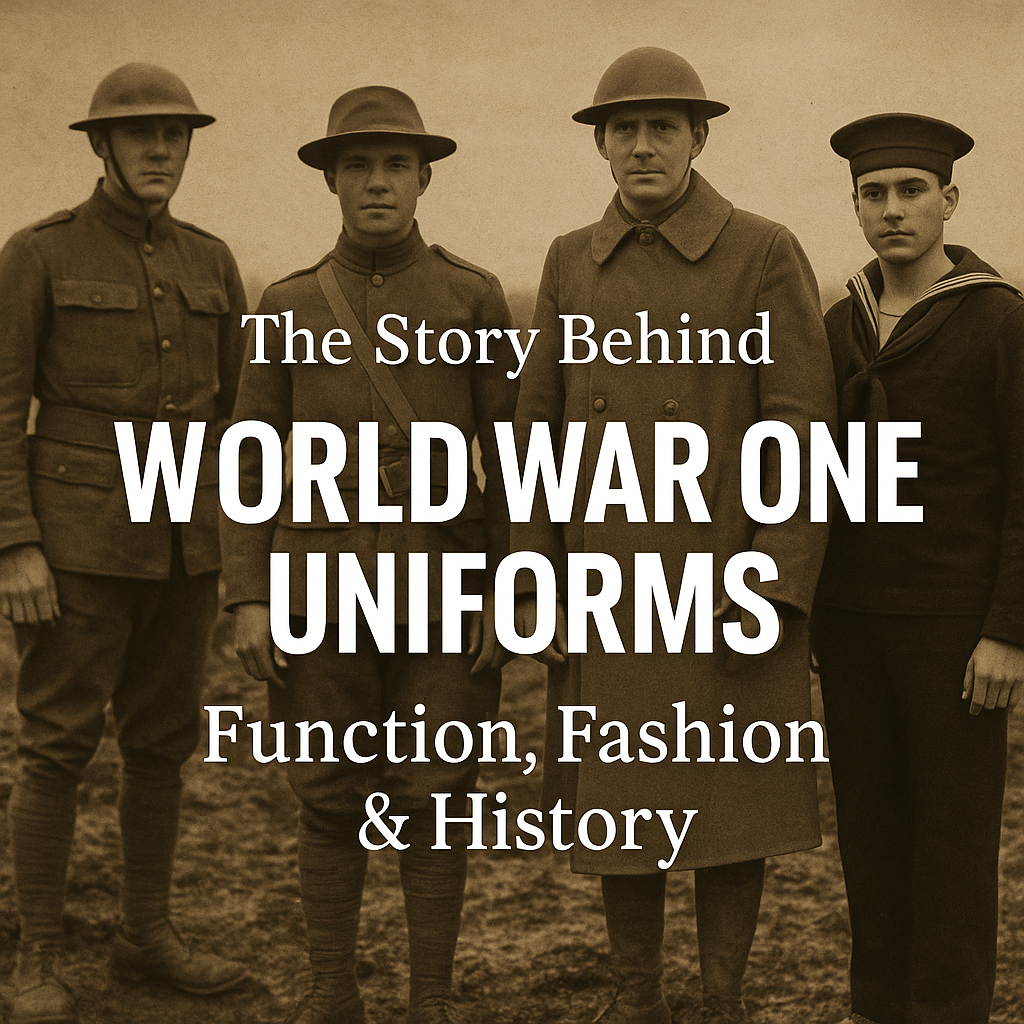
The Story Behind World War One Uniforms: Function, Fashion & History"
Published on Jun 22, 2025
World War I Uniforms: A Comprehensive Guide to Great War Attire
World War I was a turning point in global history, not only for its massive scale and devastating impact but also for the significant transformation in military gear and clothing. Among the most iconic relics of this era are World War I uniforms—a reflection of both tradition and the harsh realities of modern warfare.
Whether you're researching for a history project, building a reenactment outfit, or looking to purchase World War One uniforms for sale, understanding their history and components is essential.
The Evolution of Military Uniforms: From Formal Dress to Functional Gear
Before World War I, military uniforms were often ornate, with bright colors, elaborate decorations, and impractical designs inherited from earlier centuries. However, the Great War marked a significant shift toward functionality, camouflage, and standardization—driven by the demands of trench warfare and mechanized conflict.
Fun Fact: The term “khaki,” derived from the Persian word for "dust," became widely adopted during this period due to its camouflage advantages in muddy, battlefield conditions.
Explore more in our dedicated post on the History of Military Uniforms.
Clothing in World War 1: What Soldiers Wore in the Trenches
Clothing during World War 1 was heavily influenced by the harsh environments soldiers faced—mud, rain, snow, and chemical weapons. The average soldier's outfit was not just about national pride but survival.
Typical WW1 Uniform Components Included:
- Tunic and Trousers: Usually made from wool, providing insulation in the damp trenches.
- Puttees: Strips of cloth wound around the lower leg to protect from mud and cold.
- Helmet: The famous Brodie helmet introduced in 1915 helped protect against shrapnel.
- Gas Mask: Essential gear due to frequent chemical attacks.
- Boots: Sturdy but often ill-suited for prolonged wet conditions, leading to the infamous "trench foot."
Discover the detailed breakdown of soldier gear in our post on Clothing in World War 1.
WW1 U.S. Uniforms: A Blend of European Influence and American Identity
The United States entered the war in 1917, and their uniforms reflected a mix of American innovation and existing European styles.
Key Features of WW1 U.S. Army Uniforms:
- Olive Drab Wool Tunic: Designed for durability and warmth.
- M1917 Helmet: A U.S.-produced version of the British Brodie helmet.
- Canvas Leggings: Replacing traditional puttees.
- Overcoat (Greatcoat): Heavy, double-breasted, and ideal for cold climates.
Unlike some European forces, the U.S. military focused more on utility and simplicity. The uniform had fewer decorative elements and prioritized protection and practicality.
Explore more in our dedicated pillar page on WW1 US Uniform.
World War I Navy Uniforms: Tradition Meets Modern Combat
Naval forces during WW1 played crucial roles in blockades, convoy protection, and sea battles. Their uniforms maintained a distinctive maritime style, while incorporating necessary updates for modern warfare.
Common Elements of WW1 Navy Uniforms:
- Double-breasted Pea Coats: Designed for cold sea conditions.
- Flared Trousers: Practical for movement aboard ships.
- Flat Hats with Ribbons: Marking sailor ranks and affiliations.
- Black or Blue Wool Material: Durable and easily recognizable.
Naval uniforms, while more traditional in appearance, saw updates in accessories and protective gear. Sailors often carried life vests and basic gas masks.
Dive deeper into the evolution in our post on World War I Navy Uniforms.
Why Collect or Buy World War One Uniforms Today?
WWI uniforms are sought after by collectors, reenactors, and educators alike. Whether you're participating in living history events or building a home museum, authentic uniforms offer a tangible connection to the past.
At Paddelaters.com, we offer carefully sourced and replica World War One uniforms for sale, including:
- U.S. Infantry gear
- British Tommy sets
- Navy dress and work uniforms
- Accessories like belts, helmets, and gas masks
Every item is selected for historical accuracy and craftsmanship, making it ideal for display or reenactment.
How to Choose the Right WW1 Uniform for Your Needs
Here are a few quick tips when selecting a WW1 uniform:
- Determine the Nation and Branch: U.S. Army? British Infantry? French Foreign Legion?
- Pick the Era-Accurate Style: Early-war and late-war designs differ significantly.
- Check for Historical Authenticity: Look for replica quality if not buying originals.
- Buy from Reputable Sellers: Like Paddelaters.com, where every item is verified for authenticity.
Conclusion: Preserving History Through Uniforms
World War I changed everything—from geopolitics to battlefield technology. The uniforms of that era serve as visual records of this transformation. They represent bravery, innovation, and the human cost of modern conflict.
Whether you're here to buy World War One uniforms, learn about clothing in WW1, or delve into the history of military uniforms, your journey into the past starts with what soldiers wore
